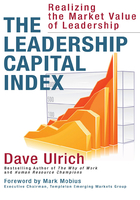
Emotional Identity and Well-Being
Emotional intelligence has become an indicator of leadership effectiveness in many situations. Emotional intelligence deals with self-awareness, identity, and stability. Investors who ascertain the emotional intelligence and well-being of key leaders will have more confidence in future performance.
Emotional intelligence deals with self-awareness, identity, and stability. Investors who ascertain the emotional intelligence and well-being of key leaders will have more confidence in future performance.
Self-awareness means that leaders are able to monitor their own behavior and maintain a healthy ego. An understanding of personal work preferences helps leaders take on the right work. In the following pairs, which seems more congenial?
In the following pairs, which seems more congenial?
 Strategic or tactical issues
Strategic or tactical issues
 Ideas or things
Ideas or things
 Large groups or small groups
Large groups or small groups
 Creative or operational activities
Creative or operational activities
 Nontechnical or technical questions
Nontechnical or technical questions
 Experimental or routine work
Experimental or routine work
 Programs or projects
Programs or projects
 Collaborative or individual efforts
Collaborative or individual efforts
 Interpersonal or sol work
Interpersonal or sol work
 High-risk or low-risk situations
High-risk or low-risk situations
 Self-directed or supervised work
Self-directed or supervised work
As leaders consciously make these personal choices, investors can also become aware of leader preferences to ensure that leaders are in the right job with the right skills.
Self-awareness also addresses the trade-off between self-interest and humility. Sometimes, egocentricity can get in the way—a leader who uses "I” messages too often and does not let others speak up can miss out on vital information. One investor described meeting with a leadership team and asking questions about future strategy. On every question, the most senior leader in the room gave a long and detailed answer. No one else spoke up. Even when the questions addressed areas in the purview of others in the room, the senior leader dominated the conversation. The investor left less confident in the leadership team as a whole and concerned that the senior leader was not aware of how his ego cast a shadow on his firm’s performance.
Ego strength can also get in the way. Leaders who treat less prominent people with little respect may be allowing their positions to define their egos. It can be useful to watch the leader’s interactions with wait staff, parking attendants, and others outside the office, and to find an occasion to talk to the leader’s administrative assistants to get a sense of the leader’s expressions of ego and style.
Investors can observe leaders' sense of humility when they have low self-focus, are open to feedback, listen intently, ask probing questions, and acknowledge weaknesses. Self-awareness also means that the leader is willing to turn to others who have complementary skills.
Emotional well-being shows up as a positive leadership trait when leaders have an identity that builds confidence in others. Another investor we spoke with likes to discover whether leaders have a clear sense of who they are and who they want to become by asking about their personal aspirations.
In one company, a senior officer was known as a "frat house member” because he wanted to be treated like one of the guys. Key investors who learned of this became concerned with the messages this identity communicated, feeling that it signaled a lack of the discipline required of senior leaders.
Finally, emotional well-being shows up in how a leader manages stress and high demand. Just as people tend to swear in their native tongue, they return to their inherent leadership style under stress. Some investors intentionally push leaders to see how they respond to conflict, differences of opinion, and high expectations. Emotionally grounded leaders tend to respond to stress by showing greater calmness, curiosity, and compassion.
Discerning emotional well-being is more art than science; more intuition than empirical data. Investors' ability to ascertain emotional well-being increases when they explicitly focus on self-awareness, identity, and stress management.
Possible indicators:
 Does the leader have a personal identity that matches personal strengths and needs of the business?
Does the leader have a personal identity that matches personal strengths and needs of the business?
 How does the leader handle emotional demands and stress?
How does the leader handle emotional demands and stress?
 Does the leader manage ego, balancing confidence and humility? Does the leader often talk in terms of "I” messages or "we” messages?
Does the leader manage ego, balancing confidence and humility? Does the leader often talk in terms of "I” messages or "we” messages?